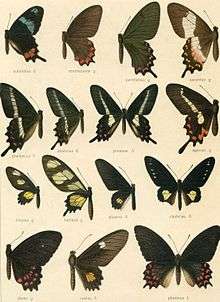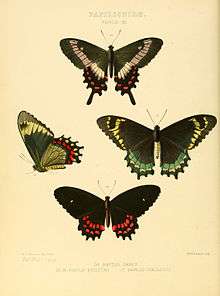Parides photinus
Parides photinus, the pink-spotted cattleheart, is a species of butterfly in the family Papilionidae. It was first described by Edward Doubleday in 1844.
| Pink-spotted cattleheart | |
|---|---|
.jpg) | |
| Ventral view | |
| Mounted specimen on display at Museo di Scienze Naturali Enrico Caffi, Bergamo. Dorsal view | |
| Scientific classification | |
| Kingdom: | |
| Phylum: | |
| Class: | |
| Order: | |
| Family: | |
| Tribe: | |
| Genus: | |
| Species: | P. photinus |
| Binomial name | |
| Parides photinus (Doubleday, 1844) | |
| Synonyms | |
| |
Description
Parides photinus has a wingspan reaching 90–100 millimetres (3.5–3.9 in). Adults are black with the hindwing having a blue-green metallic sheen especially in the male. There are no wing bands. Two rows of red spots are found along the hindwing margin.[1][2] The submarginal spots strongly arched except the upper two or three and the anal one; the latter distinct on upperside only in the female. The hindwings have short tails. The undersides are similar to the upsides. The larvae feed on Aristolochia grandiflora and A. asclepiadifolia.[3][4] A full description is provided by Rothschild, W. and Jordan, K. (1906)[5]
Distribution and habitat
This species can be found from Mexico to Costa Rica, in Nicaragua and in Honduras. It lives in forests, where it is common to abundant. Its range extends from the sea level to 5000 feet (1500 metres).[6]
Gallery
 Parides photinus from The Macrolepidoptera of the World, Jordan, K., in Seitz, A. (1907)
Parides photinus from The Macrolepidoptera of the World, Jordan, K., in Seitz, A. (1907) Parides photinus from New Species of Exotic Butterflies (1869). Plate: Papilio XI
Parides photinus from New Species of Exotic Butterflies (1869). Plate: Papilio XI
Taxonomy
Parides photinus is a member of the ascanius species group [7] ("Fringe-spots white. Hindwing with submarginal spots and unusually also discal spots or dots, or a discal band; mostly with tail").A quadrate whitish spot in space 2 of the forewings is quite peculiar of the ascanius group[8]
The members are:
- Parides agavus (Drury, 1782)
- Parides alopius (Godman & Salvin, [1890])
- Parides ascanius (Cramer, [1775])
- Parides bunichus (Hübner, [1821])
- Parides gundlachianus (C. & R. Felder, 1864)
- Parides montezuma (Westwood, 1842)
- Parides phalaecus (Hewitson, 1869)
- Parides photinus (Doubleday, 1844)
- Parides proneus (Hübner, [1831])
References
- "Winged Wonders". Oregon Zoo. 2005. Retrieved 19 December 2010.
- Lewis, H. L. (1974). Butterflies of the World ISBN 0-245-52097-X Page 26, figure 21.
- Savela, Markku. "Parides photinus (Doubleday, 1844)". Lepidoptera and Some Other Life Forms. Retrieved March 31, 2018.
- Seitz, A. ed. Band 1: Abt. 1, Die Großschmetterlinge des palaearktischen Faunengebietes, Die palaearktischen Tagfalter, 1909, 379 Seiten, mit 89 kolorierten Tafeln (3470 Figuren)

- Rothschild, W. & Jordan, K. (1906). "A revision of the American Papilios". Novitates Zoologicae. 13: 411-752. (Facsimile edition ed. P.H. Arnaud, 1967)

- Collins, N. Mark; Morris, Michael G. (1985). "Parides photinus (Doubleday, 1844)". Threatened Swallowtail Butterflies of the World: The IUCN Red Data Book. Gland & Cambridge: IUCN. p. 67. ISBN 978-2-88032-603-6 – via Biodiversity Heritage Library.
- Edwin Möhn, 2007 Butterflies of the World, Part 26: Papilionidae XIII. Parides Verlag Goecke & Evers Verlag Goecke & Evers ISBN 9783937783277
- Racheli, Tommaso an Olmisani. Luca 1998. A cladistic analysis of the genus Parides Hubner, [1819], based on androconial structures (Lepidoptera: Papilionidae). Neue Ent. Nachr. (Marktleuthen),41:119-131.pdf
Further reading
- Lamas, Gerardo (2004). Atlas of Neotropical Lepidoptera; Checklist: Part4A Hesperioidea–Papilionoidea. Gainesville, Florida: Scientific Publishers, Inc. p. 93. ISBN 0-945417-28-4.
External links
| Wikimedia Commons has media related to Parides photinus. |
| Wikispecies has information related to Parides photinus |